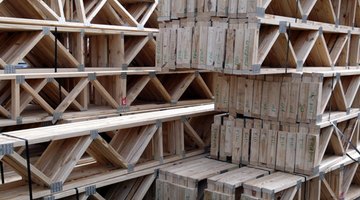How to Build a Wood Floor Truss
One of the most common support systems for floors in houses and commercial buildings is the open-web truss system. Their appearance makes them seem easy to build because they look as if they are just straight pieces of lumber with angled pieces between them.

However, several aspects of building, such as weight and the span that needs the truss determine their construction. Raised Floor Living, in conjunction with Southern Forest Products Association developed a table to help understand how trusses are built.
Things You Will Need
- 2 pieces of 2-by-4-by-144-inch lumber
- Framing square
- 13 pieces of 2-by-4-by-6 1/4-inch lumber
- 16-penny box nails
- Hammer
- 3 pieces of 2-by-4-by-96-inches
- Electric miter saw
- Truss nail tooth plate, 3-by-3-inch
Tip
Check all measurements twice to avoid wasting lumber.
Warning
Do not build a floor truss without understanding how to build it to fit your specific needs.
Do not leave power tools within reach of children.
-
Lay the two pieces of 2-by-4-by-144-inch lumber on a worktable. Measure from one end of the lumber and make marks every 16-inches. Make marks 3/4-inch to the left and the right of the 16-inch marks.
-
Place the framing square on the marks on either side of the 16-inch marks and draw lines across the lumber. The space between the lines indicates the placement of the vertical pieces, or lateral braces, of the truss. Separate the 144-inch pieces about 6-inches. Stand them on one of their 1 1/2-inch edges so the lines are facing each other.
-
Set one of the 2-by-4-by-6 1/4-inch pieces between the 144-inch pieces on either end. Secure the 6 1/4-inch piece to the 144-inch pieces with the box nails.
-
Put the remaining 6 1/4-inch pieces between the lines drawn on the 144-inch pieces. Secure them with the box nails. Lay the truss on the table so the 1 1/2-inch edges are facing up.
-
Set the electric miter saw on a 30-degree angle. This angle may vary a little depending on the actual placement of the pieces of the truss. Put the 3 1/2-inch side of a 2-by-4-by-96-inch piece against the fence of the electric miter saw and cut the end of it at the angle. Place the long point of the miter against the 6 1/4-inch lateral brace where it meets one of the 144-inch pieces.
-
Adjust the other end of the 2-by-4-by-96-inch piece so the top of it sits on the corner created by the lateral brace on the end of the truss and the 144-inch piece, or chord, of the truss. Mark the stud where it meets that corner. Set the 3 1/2-inch edge against the fence of the miter saw and cut the angle. This is the web of the truss.
-
Check for a good fit and adjust the angle if necessary. Place it in the truss and secure it at both ends with the truss plates and a hammer. Repeat this for each space between the lateral braces. Turn the truss over and secure that side of the web pieces with the truss plates.
The Drip Cap
- One of the most common support systems for floors in houses and commercial buildings is the open-web truss system.
- Secure the 6 1/4-inch piece to the 144-inch pieces with the box nails.
- Lay the truss on the table so the 1 1/2-inch edges are facing up.
- This angle may vary a little depending on the actual placement of the pieces of the truss.
- Place the long point of the miter against the 6 1/4-inch lateral brace where it meets one of the 144-inch pieces.
- Turn the truss over and secure that side of the web pieces with the truss plates.
Resources
Writer Bio
Michael Straessle has written professionally about the construction industry since 1988. He authored “What a Strange Little Man,” among other books, and his work has appeared in various online publications. Straessle earned a Bachelor of Arts from the University of Arkansas at Little Rock in professional/technical writing.
Photo Credits
- floor trusses image by jimcox40 from Fotolia.com
- floor trusses image by jimcox40 from Fotolia.com
More Articles



